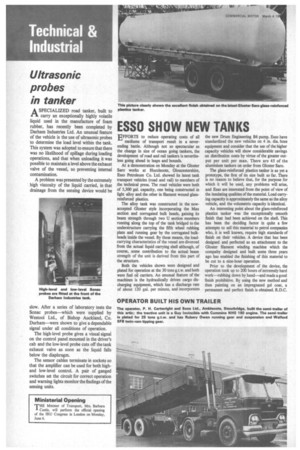ESSO SHOW NEW TANKS
Page 64

If you've noticed an error in this article please click here to report it so we can fix it.
EFFORTS to reduce operating costs of all
mediums of transport result in a neverending battle. Although not so spectacular as the change in size of ocean going tankers, the development of road and rail tankers is nevertheless going ahead in leaps and bounds.
At a demonstration on Monday at the Gloster Saro works at Hucclecote, Gloucestershire, Esso Petroleum Co. Ltd. showed its latest tank transport vehicles (road and rail) to members of the technical press. The road vehicles were both of 5,300 gal. capacity, one being constructed in light alloy and the other in filament wound glassreinforced plastics.
The alloy tank was constructed in the nowaccepted Gloster style incorporating the Max section and corrugated bulk heads, gaining its beam strength through two U section members running along the top of the tank bridged to the understructure carrying the fifth wheel rubbing plate and running gear by the corrugated bulkheads inside the vessel. By these means, the loadcarrying characteristics of the vessel are divorced from the actual liquid carrying shell although, of course, some contribution to the actual beam strength of the unit is derived from this part of the structure.
Both the vehicles shown were designed and plated for operation at the 30 tons g.t.w. and both were fuel oil carriers. An unusual feature of the machines is the hydraulically driven cargo discharging equipment, which has a discharge rate of about 120 gal. per minute, and incorporates the new Drum Engineering B6 pump. Esso have standardized the new vehicles on 4 in. dia. hose equipment and consider that the use of the higher capacity vehicles will show considerable savings on distribution costs by virtue of the greater output per unit per man. There are 45 of the aluminium tankers on order from Gloster Saro.
The glass-reinforced plastics tanker is as yet a prototype, the first of its size built so far. There is no reason to believe that, for the purpose for which it will be used, any problems will arise, and Esso are interested from the point of view of the insulating qualities of the material. Load carrying capacity is approximately the same as the alloy vehicle, and the volumetric capacity is identical.
An interesting point about the glass-reinforced plastics tanker was the exceptionally smooth finish that had been achieved on the shell. This has been the deciding factor in quite a few attempts to sell this material to petrol companies who, it is well known, require high standards of finish on their vehicles. A device that has been designed and perfected as an attachment to the Gloster filament winding machine which the compaby designed and built some three years ago has enabled the finishing of this material to be cut to a nine-hour operation.
Prior to the development of the device, the operation took up to 200 hours of extremely hard work—rubbing down by hand—and made a good finish prohibitive. By using the new method and then painting on an impregnated gel coat, a permanent and perfect finish is obtained. R.D.C.
























































































































































